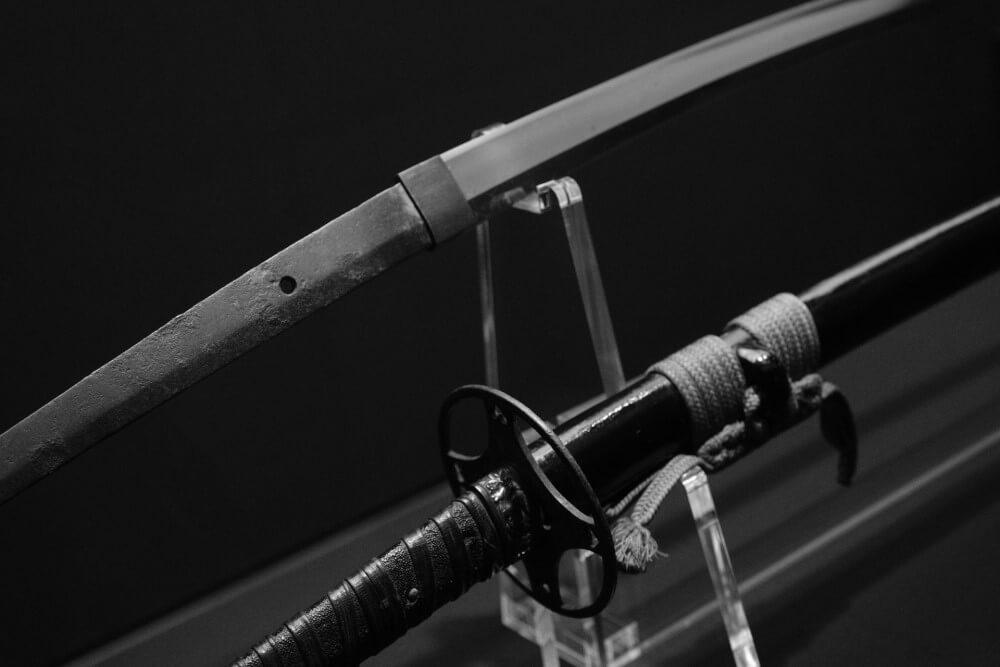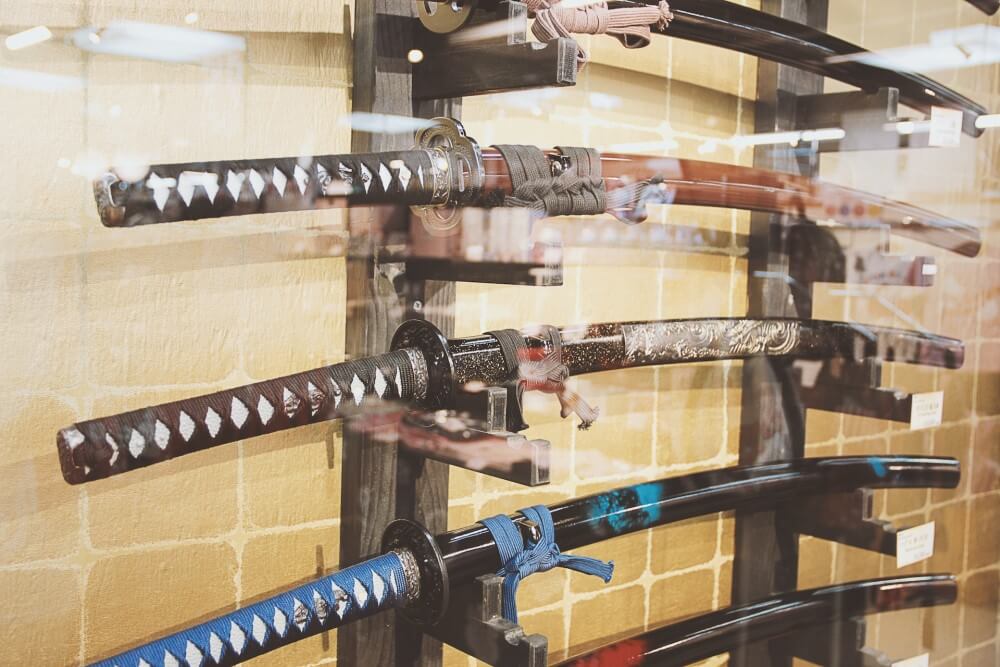- Life & Culture
Types of Japanese Swords: History, Uses & Names
If you’re interested in the history of Japan, you’ll know the country has a rich military past. The samurai warrior is an enduring Japanese icon, appearing in manga, movies and anime series.
Japanese swords are known for their elegance, but did you know their names and uses?
Here’s everything you need to know about 10 iconic types of Japanese swords – from how to tell the difference between them, to what they’re called and how they were used in Japan.
10 Iconic Types of Japanese Swords
Katana
An iconic symbol of Japanese culture, the katana is a single-edged sword that is traditionally made from steel. It has a distinctive appearance and is typically made of fine materials.
Still revered today for its beauty and craftsmanship, the katana sword was used by samurai warriors in Japan for centuries. The blade is long and curved, skillfully forged from multiple layers of steel to add strength and flexibility, which is then heated up in clay to harden the edge.
Traditional Japanese katanas have a comfortable handle, finished with a wrap of silk or leather. Many museums in Japan feature katana swords, and some even let you forge your own!
Length: 60-80cm Shape: Long and curved Used By: Samurai warriors
Wakizashi
Unlike the more exclusive katana, the wakizashi was worn by merchants as well as warriors.
A companion sword to the katana, the wakizashi is similar in its shape and design, but shorter. Samurai warriors also used this type of Japanese sword, most commonly as a secondary weapon for close combat, or as a backup sword if their katana was lost or damaged.
However, some samurai preferred to use a wakizashi as a first choice, due to its compactness. Its size also made it easier to use indoors, where an unsheathed katana was too unwieldy.
As the use of swords waned in Japan, both types became a more decorative status symbol.
Length: 30-60cm Shape: Short and curved Used By: Samurai and non-warriors
Tachi
Another type of Japanese sword with similarities to the katana, the tachi is longer in length and has an even older history. Both have elegant, single-edged blades and comfortable handles.
While the ‘modern’ katana appeared in the military nobility of feudal Japan (1185-1600), the tachi was around much earlier – first being developed around 900. Even when their popularity was outstripped by the katana, the tachi was still worn by high-ranking samurai as a status symbol.
Next to the katana, the larger tachi also has a much more prominent curve and was designed to be used on horseback. The rare early tachi that survive today are priceless pieces of history.
Length: 70-80cm Shape: Long and deeply curved Used By: Samurai warriors
Tanto
More of a dagger than a type of sword, a tanto is a short single-edged blade with a square tip.
Like the slightly longer wakizashi sword, the Japanese tanto was often used by samurais as a companion and secondary weapon to the famous katana. As well as combat, they can be used for more everyday things like chopping food – they’re still used today as general utility knives.
The tanto first appeared in the Heian period (794-1185) of Japanese history. Before the more popular sword combo of katana and wakizashi, it was common to carry a tachi and tanto.
There are many subtypes of tanto, including the kaiken which was popular with women.
Length: 15-30cm Shape: Small and straight Used By: Samurai warriors and women
Tsurugi
A double-edged longsword from ancient Japan, the tsurugi has many differences from the katana, wakizashi and tanto. All these other types of Japanese swords are single-edged.
The tsurugi doesn’t have the distinctive curved shape associated with many Japanese swords.
Another difference between the tsurugi and more well-known Japanese swords is that the tsurugi is from a much earlier period in Japanese history. Many surviving tsurugi in Japan are from around 200 BC, and it’s thought this was the heyday when this type of sword was produced.
From around the 10th century, the tsurugi stopped being used as a weapon and even for religious services. It is now mostly seen in myths and legends from ancient Japan.
One of the Three Imperial Regalia of Japan is a tsurugi sword. It is always kept hidden.
Length: 90-100cm Shape: Long and straight Used By: Ancient samurai warriors

Shinobigatana
Also known as the ninjato, the shinobigatana sword is said to be the preferred weapon of ninjas.
However, there is some debate about the historical accuracy of the shinobigatana. There are no examples of this type of sword before the 20th century, but it often appears in films and on stage.
In fact, the very existence of the ninjato sword is questioned by experts on Japanese swords, with some dismissing it as a Hollywood invention to give ninjas their own distinctive sword! Whether it does or doesn’t exist, the shinobigatana is an iconic symbol of ninjas in pop culture.
The classic shinobigatana sword is quite similar to a katana, only straighter and shorter.
Length: 30-60cm Shape: Compact and straight Used By: Ninjas in pop culture
Yoroi-dōshi
Known as the ‘mail piercer’, the yoroi-dōshi is an extra thick type of Japanese tanto short sword. It appeared in the 14th century and was primarily used for close combat while grappling.
Typically shorter than the tanto, this sword has a distinctive shape that sets it apart from other types of Japanese swords. It is double-edged and has a shorter hilt, making it easy to handle in cramped conditions. The sword is specifically designed for piercing armour during a battle.
Another interesting feature of the yoroi-dōshi is the kozuka – a small utility knife stored in its hilt. This can be used for removing arrowheads, cutting rope, or as a secondary weapon if needed.
The yoroi-dōshi sword was traditionally used by samurai warriors, and worn inside the belt.
Length: 20-22cm Shape: Small, thick and straight Used By: Samurai warriors
Chokutō
Unlike the famous katana, the chokutō has a straight blade and literally means ‘straight sword’.
Dating back to the Yayoi period (ca. 300 BC-300 AD), this style was inspired by the ancient swords of China and Korea. Japanese swords are known for their deep and graceful curves, so the chokutō is distinctive compared to typical designs like the katana, tachi and wakizashi.
Chokutō swords were used by many different groups throughout Japanese history. They were used by the early samurai warrior class, alongside commoners and religious figures later on.
The swords are now used for ceremonial purposes or as historic items for collectors.
Length: 60-90cm Shape: Long and straight Used By: Many different groups
Nagamaki
A polearm used by samurai on the battlefield, the nagamaki is one of the largest and most impressive types of Japanese swords. Even its handle can be a couple of feet long.
The nagamaki blade is similar to the katana or tachi, but much longer and wider. It ranges in length from around two to three feet, with one curved cutting edge and one flat edge. Compared to other samurai swords, this is a larger and heavier weapon primarily used on the battlefield.
However, it still has the elegance of the katana and features the distinctive silk-wrapped handle of swords in Japan. Nagamaki means ‘long wrapping’, and the designs can be very beautiful.
Traditionally, the nagamaki was used by samurai against the cavalry as an infantry weapon.
Length: 120-130cm Shape: Very long and heavy Used By: Samurai in battle
Bokken
Not a real Japanese sword as such, the bokken is actually a wooden sword used to mimic one.
It is most often used in martial arts training, such as aikido, kendo and kenjutsu. The bokken makes a perfect replacement for sword fighting techniques – simulating the weight, size and feel of a real sword. You won’t get cut by a wooden blade and can practice moves in relative safety!
However, inexperienced trainers can still get hurt, and they’re designed more for kata.
As it’s not a real sword and not a status symbol either, bokken are often plain and functional. They come in various sizes and styles, copying popular shapes like the iconic katana.
Length: Various Shape: Various Used By: Martial arts trainers

A Brief History of Japanese Sword Making
Swordsmithing in Japan is a traditional craft that has been passed down for generations. There are five distinct periods in history, each of which introduced its own types of Japanese sword.
Jokoto period (pre-900s) The first period in Japanese sword-making history, this was characterised by primitive forging techniques and single-edged, straight blades.
Kotō period (900s–1596) This period saw the development of the curved blade that Japanese swords are known for. Different schools of swordsmithing also emerged with their own styles.
Shinto period (1596–1781) During this period, more decorative techniques were developed in Japanese sword making – these included details like gold inlay and elaborate carvings.
Shinshinto period (1781–1876) After the elaborate decor of the previous period of ‘new swords’, this time saw a return to the more traditional and simple styles of sword making.
Gendaito period (1876–1945) Modern and contemporary swords were developed in this period, with new techniques and the incorporation of some Western-style steel and machinery.
How is a Typical Japanese Sword Forged?
A lot of care and attention goes into making a traditional Japanese sword – they’re often seen as works of art as well as weapons. They are highly valued for both their sharpness and beauty.
- The blade is typically made of high-carbon steel, which is heated in a forge
- After being hammered into shape, the metal is folded multiple times for purity
- It is then refined into the desired shape by hammering again and using tools
- During the quenching and cooling process, it’s covered with clay and water
- To harden the cutting edge, it is heated again and quickly quenched in oil
- The blade is then polished with abrasive stones to create a mirror-like shine
- Handles are typically crafted from wood and wrapped with silk or leather
In conclusion, there are many different types of Japanese swords, but these 10 are particularly important in history – appearing in art, mythology and museums around Japan.
Love Japanese culture? Check out our blog on traditional Japanese clothes and accessories.
About the Author

Brian McDonough is a consultant at Interac, Japan’s largest provider of ALTs (Assistant Language Teachers). Originally from the US, Brian has lived in Japan for over 25 years, giving him a unique perspective on the cultural differences and challenges people face when moving to Japan. He has first-hand experience of working in Japan as an American.





